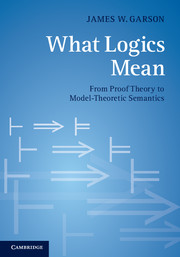Book contents
- Frontmatter
- Dedication
- Contents
- Preface
- Acknowledgements
- 1 Introduction to model-theoretic inferentialism
- 2 Deductive expression
- 3 Local expression
- 4 Global expression
- 5 Intuitionistic semantics
- 6 Conditionals
- 7 Disjunction
- 8 Negation
- 9 Supervaluations and natural semantics
- 10 Natural semantics for an open future
- 11 The expressive power of sequent calculi
- 12 Soundness and completeness for natural semantics
- 13 Connections with proof-theoretic semantics
- 14 Quantifiers
- 15 The natural semantics of vagueness (with Joshua D. K. Brown)
- 16 Modal logic
- Summary
- References
- Index
10 - Natural semantics for an open future
Published online by Cambridge University Press: 05 June 2014
- Frontmatter
- Dedication
- Contents
- Preface
- Acknowledgements
- 1 Introduction to model-theoretic inferentialism
- 2 Deductive expression
- 3 Local expression
- 4 Global expression
- 5 Intuitionistic semantics
- 6 Conditionals
- 7 Disjunction
- 8 Negation
- 9 Supervaluations and natural semantics
- 10 Natural semantics for an open future
- 11 The expressive power of sequent calculi
- 12 Soundness and completeness for natural semantics
- 13 Connections with proof-theoretic semantics
- 14 Quantifiers
- 15 The natural semantics of vagueness (with Joshua D. K. Brown)
- 16 Modal logic
- Summary
- References
- Index
Summary
(This chapter draws heavily from Garson (2013) “Open Futures in the Foundations of Propositional Logic,” in Nuel Belnap on Indeterminism and Free Action, T. Mueller (ed.), Springer, New York.)
The natural semantics ‖PL‖ for classical logic has a number of interesting applications. This chapter will discuss its merits as a semantics that takes seriously the notion that the future is open (Section 10.1). Here future possibilities are represented as a branching structure, with choice points at each node. The ‖PL‖ models developed in Chapter 8 are well suited to this idea, since the frame <V, ≤> sets up that kind of structure. Furthermore, as Sections 10.3 and 10.4 show, the side condition ‖LF‖ and the quasi-truth reading ‖q∨‖ of disjunction match well with our concerns to locate the propositions that express events over which one might have control.
‖LF‖ If v(A)=f, then for some v′, v≤v′ and v′(A)=F.
‖q∨‖ v(A∨B)=t iff for all v′∈V, if v≤v′, then v′(A)=qT or v′(B)=qT.
In Section 10.5, it is shown that ‖PL‖ can be used to refute arguments that purport to show the inescapability of fatalism. The frame <V, ≤> is not entirely apt for modeling an open future because it need not satisfy the condition that there be no branching of possibilities in the past. Section 10.6 shows how this problem can be repaired.
- Type
- Chapter
- Information
- What Logics MeanFrom Proof Theory to Model-Theoretic Semantics, pp. 147 - 161Publisher: Cambridge University PressPrint publication year: 2013



